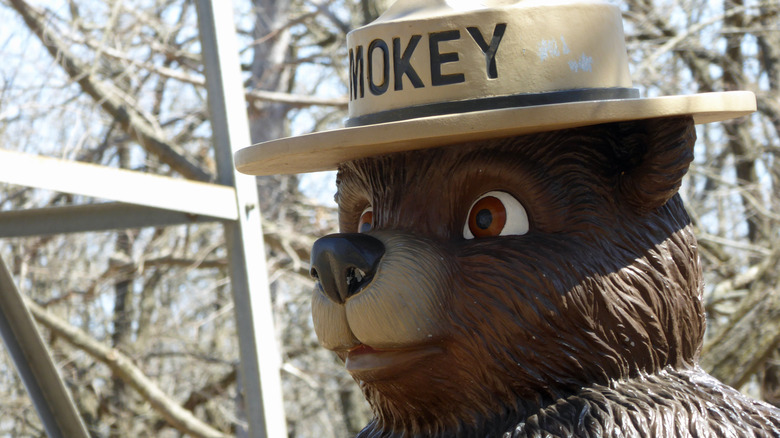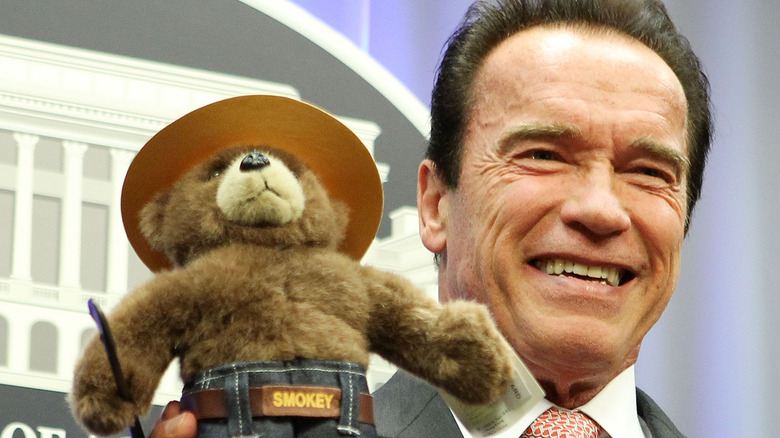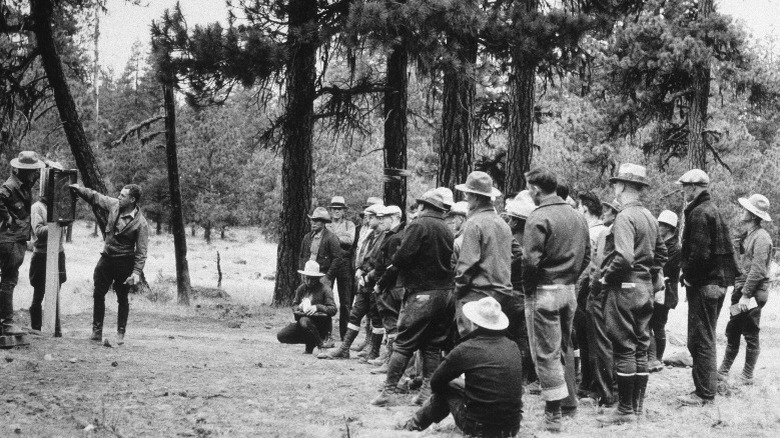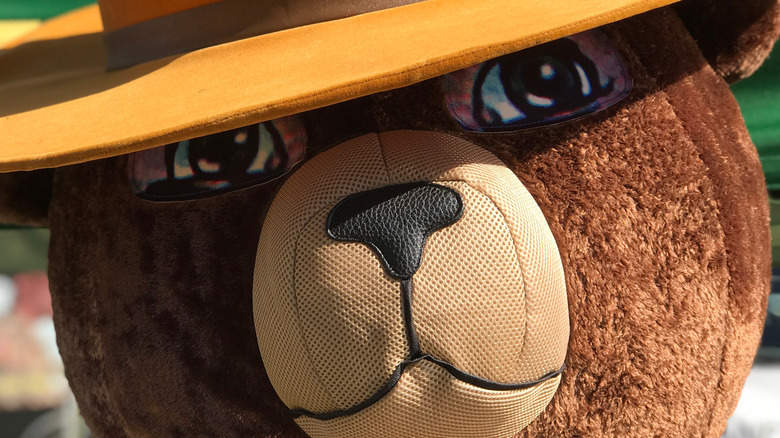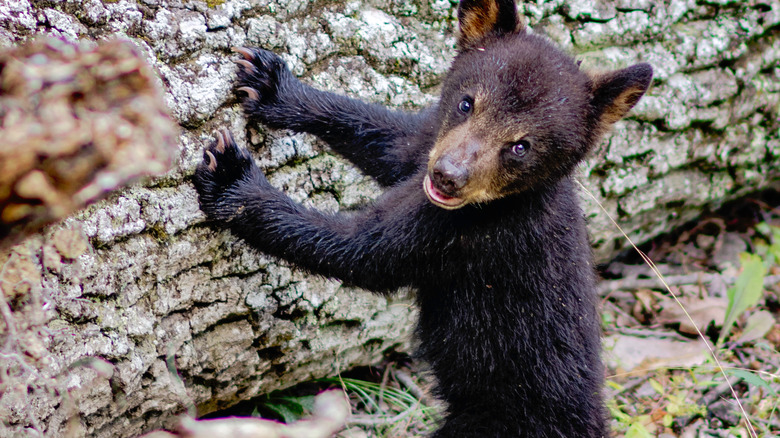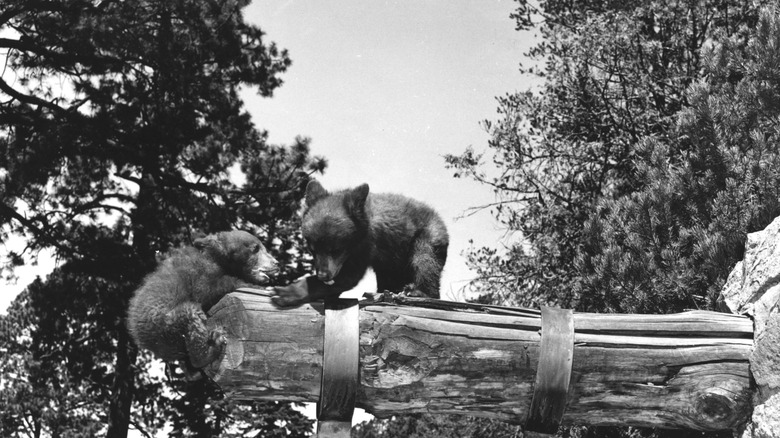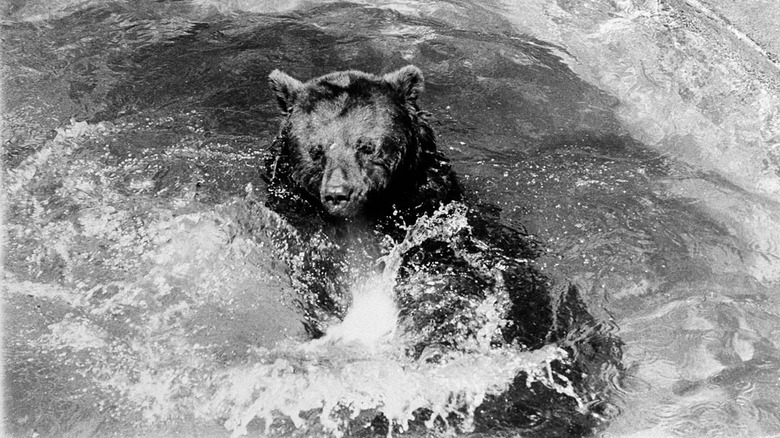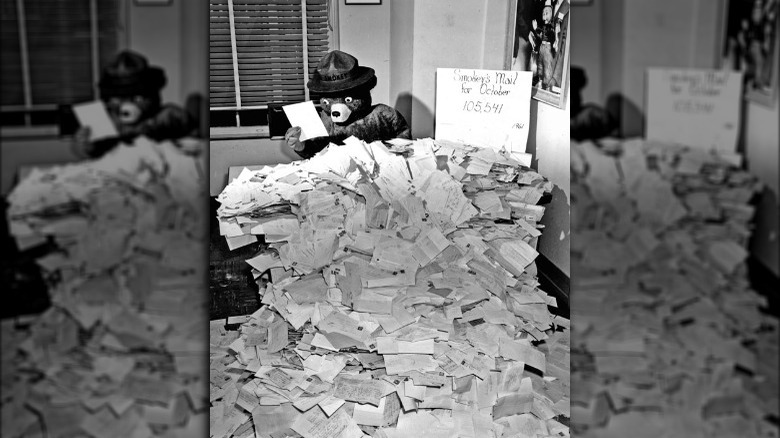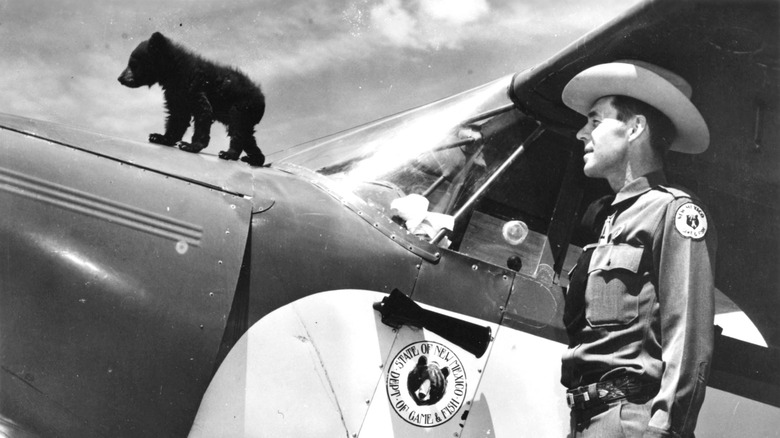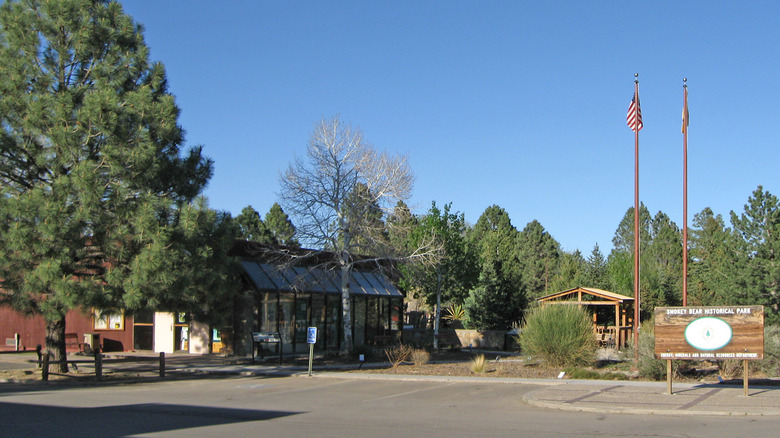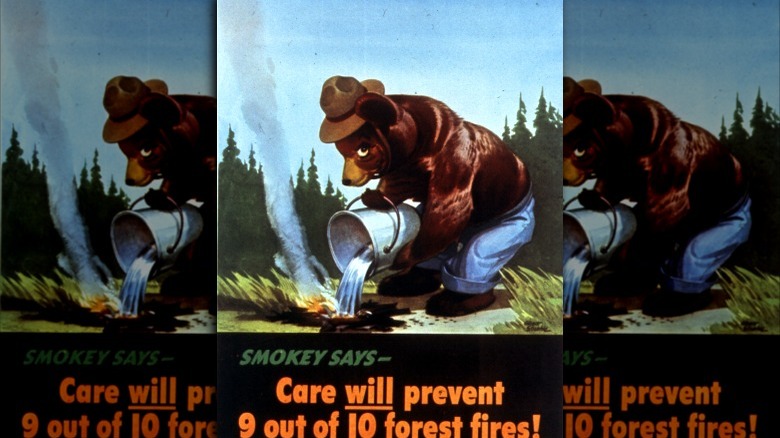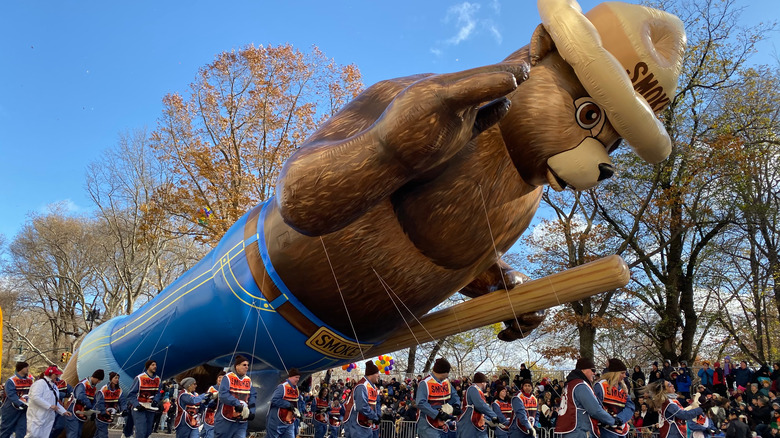The Untold Truth Of Smokey Bear
Few public figures have proven more recognizable. From the bottom of his blue jeans to the top of his ranger hat, the oddly anthropomorphic physique to the gruff voice. He barks orders like a drill sergeant on the first day of boot camp, and he rarely cracks a smile. But one thing's for sure. He knows how to bring the pain when it comes to those with a penchant for smoking in forests or improperly extinguishing campfires. In other words, he's Liam Neeson with brown fur and a "certain skill set" that leaves arsonists quaking in their boots.
All kidding aside, there's a lot you may not know about the United States Forest Service's top dog ... that is, top bear, Smokey. He's long represented a symbol of responsible land use. And he's brought awareness about dangerous fire practices to several generations of American children. Yet, most people don't even get his name right. (For the record, the correct version has no article.)
But the fascinating and untold truth about everyone's favorite ursine firefighter doesn't end there. Here are some little-known facts about one of the most influential (and hairy) critters of the 20t and 21st centuries, Smokey Bear.
Which came first, the mascot or the bear?
Baby Boomers may tell you Smokey Bear started as a real-life cub. Yet, the mascot pre-dates the orphaned bear cub, according to the Forest Service. The ursine ranger replaced Bambi, the original face of the Forest Service. Yes, you read that right. Bambi. The cuddly orphaned fawn with a rabbit sidekick once symbolized the United States Forest Service (USFS). But Disney refused to license the deer for more than one year.
Fortunately, this worked in the USFS's favor. Sure, Bambi had the "cute" factor going. But could he really put the fear of God in campers with sloppy fire practices? Let alone arsonists? No way! The USFS needed a no-nonsense figure capable of being both likable and imposing. (Think Arnold Schwarzenegger's Terminator-turned-drapery-salesman, Carl, in "Terminator: Dark Fate.") Enter the world's first "spokes-ursus."
The cartoon version of Smokey Bear came into existence on August 9, 1944, thanks to the USFS and the Ad Council, per the South Dakota Department of Agriculture (SDDA). Albert Staehle painted the first poster of the now near-mythic creature, using a bucket filled with water to extinguish fire flames properly. The poster also featured the rather clunky message, "Care will prevent 9 out of 10 fires." Doesn't quite roll off the tongue, does it? Fortunately, three years later the USFS settled on the much catchier, "Only YOU can prevent forest fires!" As for the real-life cub named Smokey? He wouldn't show up until 1950.
WWII helped launch Smokey's career
During WWII, forest and natural resource management became pressing issues in the U.S., per NPS History. For starters, wood production saw a massive uptick through the Timber Production War Project. Why? Because an insatiable need for wooden crates to transport supplies to frontline troops emerged. And that was just the beginning. Construction projects also increased the demand for wood, from ships to docks, barracks to railroad ties and gunstocks.
To meet the sudden, massive need for lumber, the Forest Products Laboratory in Madison, Wisconsin, rose to the occasion. In Salinas, California, the Forest Service even experimented with cultivating Guayule plants. These shrubs native to the Southwest acted as a rubber substitute since Southeast Asia's supply remained off-limits. At the height of the program, more than 200,000 acres got cultivated. Of course, neither of these activities required the face of a bear mascot. So, where did Smokey fit into the war effort picture?
Smokey Bear brought public awareness to a potential theater of war, America's forests. When Japanese submarines fired shells that combusted an oil field near the Los Padres National Forest, this underscored the message (via the SDDA). The clear and present danger of deadly forest fires reached the national spotlight. "The Cooperative Forest Fire Prevention Campaign ... was organized during the war, when it became vitally important to protect the Nation's timber supply." Smokey Bear proved symbolic of the fight to protect America's natural resources, namely its forests.
Smokey Bear or Smokey the Bear?
When first created in 1944, the blue-jeans-wearing bear everyone would come to know and love went by "Smokey Bear," according to the SDDA. But over the years, confusion came to accompany this name as some people started referring to him as "Smokey the Bear." Especially Boomers (via The Seattle Times). What made this variant of his name catch on? Blame the popular 1952 song by Jack Rollins and Steve Nelson, per WV Forestry.
Rollins and Nelson added the article because it "enhanced the song's rhythm" (via Wildfire Today). Compounding the error was a 1955 Little Golden Book, which also referred to the famed icon as "Smokey the Bear." For better or worse, the wrong name stuck. Nevertheless, "all this created confusion, but the name of the fire prevention icon is and always has been Smokey Bear."
The USFS recently worked with the Ohio Department of Natural Resources to create a new jingle correcting the bear's name. Known as the "New Smokey Bear Song," the 2015 reboot of the bear's title is accompanied by a teacher's kit. The hope? That today's students won't face the same confusion as previous generations.
Smokey Bear's real-life story went up in flames
Smokey Bear's story has a real-life component. In the spring of 1950, a wildfire raged through the Lincoln National Forest in New Mexico's Capitan Mountains, per the SDDA. During the blaze, firefighters found and rescued a three-month-old American black bear that would take the name Smokey Bear.
Firefighters found the small bear clinging to the top of a badly charred tree trunk, as reported by the Forest Service. He had severely singed paws, yet he survived the inferno that devoured the forests of the Capitan Mountains. In need of serious veterinarian intervention, the cub flew to Santa Fe, where a local veterinarian carefully treated and bandaged his wounds. As the little bear recovered, word spread across New Mexico about his plight. Soon, letters poured in inquiring about the bear's well-being. Once the Associated Press and the United Press caught hold of the story, they blasted it across national channels, capturing the public's imagination.
But how did the little orphan become Smokey Bear? New Mexico's chief game warden wrote to the chief of the Forest Service, asking if the organization wanted to adopt the cub. The warden thought dedicating the cub to fire prevention and wildlife conservation made sense. So did the USFS, and the rest is history.
He recovered with a family in New Mexico
Ray Bell, a New Mexico game warden, and his family nursed the 5-pound cub back to health. As Bell recounted to the Los Angeles Times, he placed the baby in a container about the size of a shoebox and took him home. They kept the little guy in a rabbit cage on their porch and let him lick a mixture of milk, honey, and baby food off their fingers when he had trouble eating.
As the bear recovered, Bell recalls the little guy threw his weight around with the other pets owned by the family, eating the food out of their bowls. The young bear was also "a bit of a ham." Caring for the cub was by no means a first for the family. According to the Sun Sentinel, nursing wild animals back to health came naturally for the Bells. But the family never anticipated just how popular the little bear in the rabbit cage would become.
Although Smokey's time with the Bell family proved fleeting, Bell spent his life speaking about his experiences with the bear. He used this exposure to promote conservation efforts across the nation. What's more, he made regular appearances at the Smokey Bear Museum located in Capitan, New Mexico.
Smokey became a main attraction at the National Zoo
As the adorable cub grew, he needed more space. So, he moved from Ray Bell's porch to the National Zoo in Washington, D.C., enjoying celebrity status. He attracted famous visitors like Roy Rogers and Hopalong Cassidy but was never domesticated, as reported by FSNatureLive. According to the National Zoo, Smokey proved "one of the most famous residents in the Zoo's 130-year history." Soon, the underweight cub grew into an enormous bear, weighing a whopping 400 pounds, reports The Spokesman-Review.
Smokey's popularity made a "little Smokey" irresistible to zookeepers (via the Washington Post). In 1962, they paired Smokey with a female bear named Goldie Bear. They hoped that the couple's offspring would go on to carry the title of Smokey Bear for many generations to come. But fate had different ideas. By 1971, the couple remained cub-less. So, zookeepers at the National Zoo took matters into their own hands. They brought in an orphaned cub for Smokey and Goldie to adopt. "Little Smokey" arrived in 1971 from the same forest in New Mexico as his adoptive dad. Some believe the cub may have even been related to Smokey.
In June 2019, the National Zoo opened an exhibit commemorating the 75th anniversary of Smokey Bear and the real-life animal that once lived at their facility. It represents a fitting tribute to the bear that "for a generation of zoo visitors, was the very living embodiment of national wildfire prevention," as reported by the Forest Service.
He has his own zip code
As a living icon of the Forest Service, Smokey Bear inspired a massive fan following. He was a "must-see" for visitors at the National Zoo (via the National Zoo). Soon, everyone's favorite rescued bear brought in millions of pieces of fan mail, too. From shipments of honey to heartfelt letters, the icon received so many mailings that the U.S. Postal Service issued the bear his own zip code in 1965, according to the National Fire Protection Association (NFPA).
Today, you can still use this zip code to write to him. Letters go to: Smokey Bear, Washington, D.C., 20252. What kinds of correspondence does the fuzzy icon receive today? According to the U.S. Department of Agriculture, these letters from American youth point to a bright future for conservation awareness and efforts.
One letter from a little boy reads, "Dear Smokey: I would like to be a Junior Forest Ranger and help the big rangers. I promise to look after the forest and watch out for baddies making fires and damaging trees. Love Adam." This is just one example of the millions of letters that have poured in over the years, documenting the tremendous success of the Smokey Bear campaign.
The firefighters that saved Smokey almost perished
Officials believe the fire that destroyed Smokey Bear's original ecosystem and separated him from his mother resulted from an improperly discarded cigarette or sparks from a camp stove (via the Washington Post). When smoke was spotted at one of the fire towers, an immediate call went up summoning wildland firefighters. Crews arrived, finding a fiery scene expanding rapidly, thanks to powerful winds.
As firefighters heroically battled the blaze, they caught glimpses of the bear cub they would later rescue wandering the fire line. But they ended up needing rescuing themselves. About 30 members of the crew got caught directly in the advancing inferno. According to Smokey Bear, they only survived by "lying face down on a rockslide for over an hour as the fire burned past them." After the flames subsided, the firefighters recovered the badly singed cub clinging to the treetop.
They named the tiny cub "Hotfoot Teddy" to recognize his heroic and incredible path to survival. One of the first headlines to mention the diminutive bear appeared on May 12, 1950, in Santa Fe's Associated Press. It read, "'Hotfoot Teddy,' the almost well-browned brown bear cub, is going to be all right," as reported by the El Paso Times. (In actuality, the little critter was a black bear.) Of course, everything changed, including his name, when the small bear became the embodiment of the USFS's forest fire campaigns.
The real-life bear is buried at Smokey Bear Historical Park
On November 9, 1976, the first living Smokey Bear died (via the Washington Post). The federal government returned his remains to Capitan, New Mexico. Although the cartoon version of Smokey Bear has outlived the real animal, his passing was widely mourned and acknowledged by people across the nation.
Newspapers published a mountain of obituaries. As reported by the Seattle Times, the Washington Post ran a tongue-in-cheek commemoration of Smokey Bear, who they described as a "transplanted New Mexico native who spent most of his life as a Washington, D.C., resident." The obituary also described Smokey's 15-year-long "marriage" to Goldie Bear and his adopted son. It ended with confirmation that Smokey "had been granted membership in the retired federal employees association."
Whimsical final words about the beloved bear aside, Smokey Bear made his final resting place in the Smokey Bear State Historical Park, per the USFS. And you can still visit his gravesite today. What can visitors expect on a visit? According to New Mexico's Energy, Minerals and Natural Resources Department, "the park is a true celebration of Smokey's legacy" designed to preserve the memory of this beautiful bear and the lessons he taught about forest conservation and fire safety.
He remains a pop icon with a revamped image
Like his real-life counterpart, the cartoon version of Smokey Bear continues to enjoy immense fame, per Collectors Journal. He has appeared in comic strips, radio programs, cartoons, and on posters and merchandise. Which artist is most closely associated with this famous bear? Although Albert Staehle created the original image, Rudy Wendelin became the campaign's full-time artist and Smokey's so-called "manager" from 1949 to 1973.
Over the years, Smokey Bear has enjoyed a variety of different voices. According to The New York Times, these have included Jackson Weaver of the WMAL radio station, who served as the primary voice for the bear until his death in 1992. Others have included George Walsh and even Sam Elliott, per the Seattle Times.
Smokey Bear recently received a voice makeover to celebrate his 75th birthday while bringing new awareness to fire safety in the American wilderness. A handful of celebrities have created a "chattier" and younger voice for the cartoon, including Jeff Foxworthy, Stephen Colbert, and Al Roker. According to Lisa Sherman, CEO of the Ad Council, in an interview with the Seattle Times, "Ensuring an icon like Smokey remains fresh and relevant for today's audiences is no simple task." As the longest running public service advertisement in U.S. history, it's safe to say the USFS has done an excellent job so far (via the NFPA).
Smokey Bear is protected by federal law and strict etiquette
Over the years, the Smokey Bear campaign has enjoyed tremendous success, as reported by the Seattle Times. He's had a balloon at the Macy's Thanksgiving Day Parade and even graced a Walt Disney short film. But all this popularity came with the potential for copyright infringement.
Federal law prohibits individuals from using the Smokey Bear likeness, which is administered by the National Association of State Foresters, the USDA Forest Service, and the Ad Council. According to the 18-page Smokey Bear Guidelines, "Today, Smokey Bear is a highly recognized advertising symbol and is protected by Federal law (PL 82-359, as amended by PL 93-318)" (via the Bureau of Indian Affairs).
For those who wear the Smokey Bear costume for the USFS, there's a guidebook with strict etiquette rules, too. The Seattle Times notes that only USFS and state forestry agencies may own Smokey Bear costumes, and that these costumes must be ordered solely through "authorized manufacturers." The costumes must also have the traditional Smokey Bear "look," including dark brown fur, blue jeans, a gold-colored belt buckle, and a tan ranger hat. Not only must the costume be protected from vandalism and theft, but in a strangely poetic twist when it's time to retire it, cremation is the only authorized method.
